 France (1895) – Torpedo mothership/Seaplane carrier
France (1895) – Torpedo mothership/Seaplane carrierWW1 French Cruisers
Sfax | Tage | Amiral Cecille | D'Iberville class | Dunois class | Foudre | Davout | Suchet | Forbin class | Troude class | Alger class | Friant class | Linois class | Descartes class | D'Assas class | D’Entrecasteaux | Protet class | Guichen | Chateaurenault | Chateaurenault | D'Estrées class | Jurien de la Graviere | Lamotte-Picquet classDupuy de Lome | Amiral Charner class | Pothuau | Jeanne d'Arc | Gueydon class | Dupleix class | Gloire class | Gambetta class | Jules Michelet | Ernest Renan | Edgar Quinet class
First life: As a torpedo boat mothership
The Foudre in still well remembered from, studied, and related upon as an interesting experiment and pioneering ship at the fall of the XIXth century. The Foudre “Lightning” was originally a pure product of the Jeune Ecole (“Young School”). It was a singular ship, however not unique as the Royal Navy developed the HMS Vulcan at the same time, defined as a torpedo boat carrier. The Foudre was started at Chantiers de la Gironde (near Bordeaux, Aquitaine), launched in 1895 and completed in 1897.
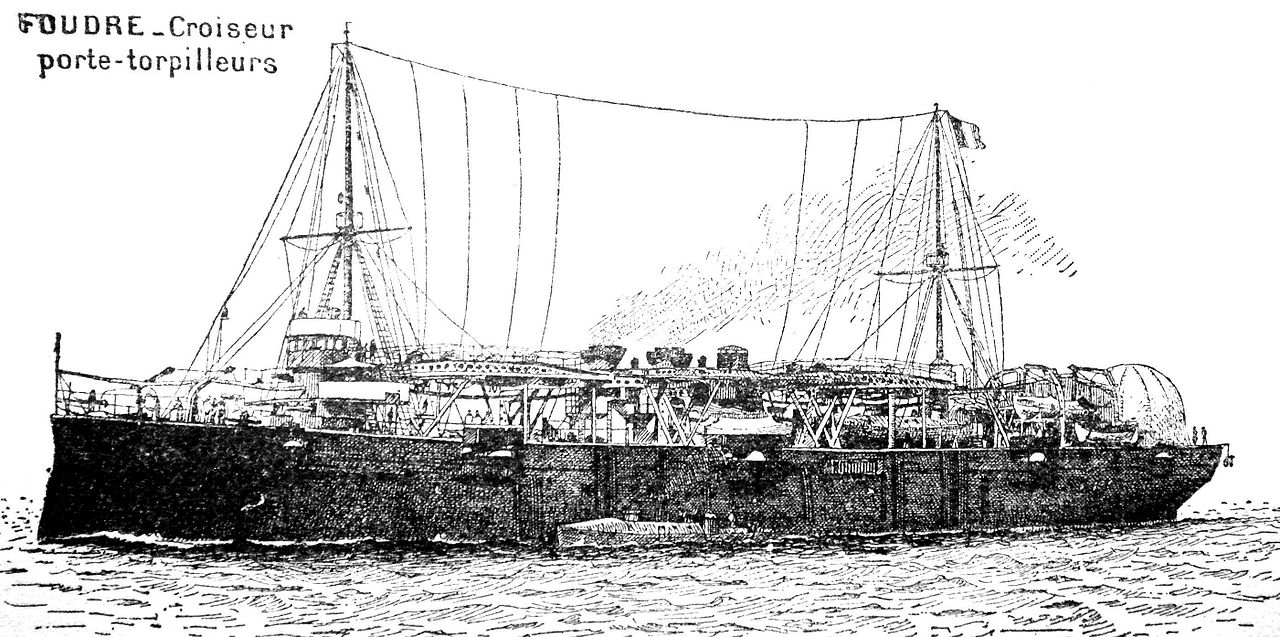
La Foudre as a torpedo boat carrier
This concept dated from the beginning of the application of torpedo boats, as it was answered the problem of limited range for these small ships. Therefore, just like modern aircraft carrier, the striking power of these TBs was extended thanks to the use of a cruiser that can be part of a fleet organically and provide a “torpedo cover”. However after being built and tried, a problem appeared soon with the seaworthiness of these very small, 18 meters TBs, too light and cramped to be effective.
Indeed, in order to fit a squadron of eight TBs on board the cruiser (four front, four rear) with rolling cranes, cross hoists to lift and put these at sea, compromises were taken. I addition to their poor seaworthiness which imposed ideal meteorologic conditions for their operation, thy only embarked two torpedo tubes rather that 4-5 on regular TBs. The British on their part arrived at the same conclusion with the Vulcan and also dropped the idea.
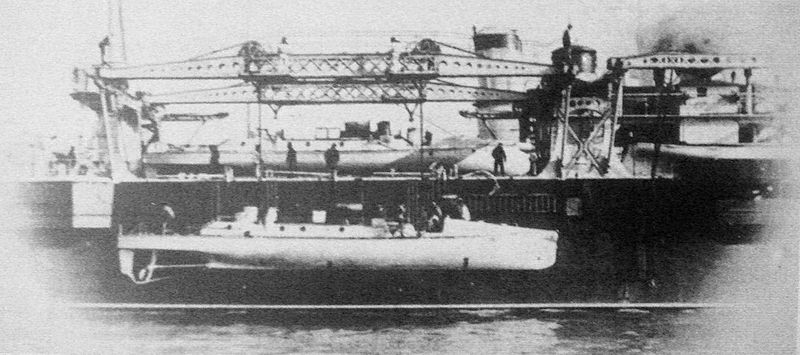
La Foudre tending a 18 m torpedo boat
Second life: As an seaplane carrier
The concept was abandoned in the late 1890s, so the Lightning was taken in hand for a minelayer conversion. In 1912, it was against converted as a seaplane carrier after a new redesign of its bridge. This second part of this carrer is quite interesting as the Foudre was the first seaplane carrier ever put into service.
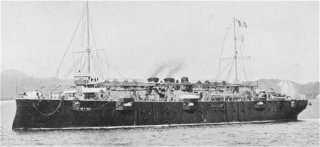
In this duty, she was fitted with a rear hangar to house 4 Canard Voisin seaplanes, and intensive tactical trials took place until 1914. As intended the Foudre can project “eyes” for the fleet well beyond the horizon. New foldable Nieuport were added to the mix and at some point during these large scale exercises, the Foudre operated no less than 11 pilots.
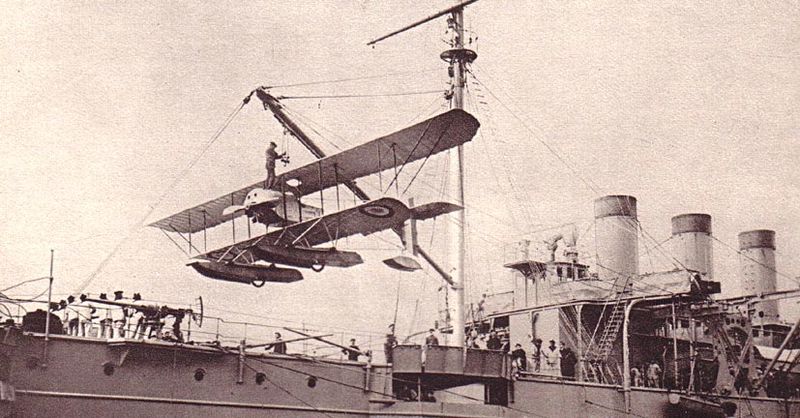
La Foudre operating a Caudron floatplane
Most flights were performed from the bay of Saint-Raphaël in the French Riveria. By the middle of 1913, in one of these opposing fleet wargames, a Nieuport used for observations again foiled a “surprise attack” by a group of warships. By November 1913 the Foudre tested a 10-meter flying-off deck at the front, to launch a Caudron G.3 seaplane, which successfully lifted off on May 8, 1914. The platform was dismantled and other experiments postponed. During the war all were replaced by much faster Caudron seaplanes.
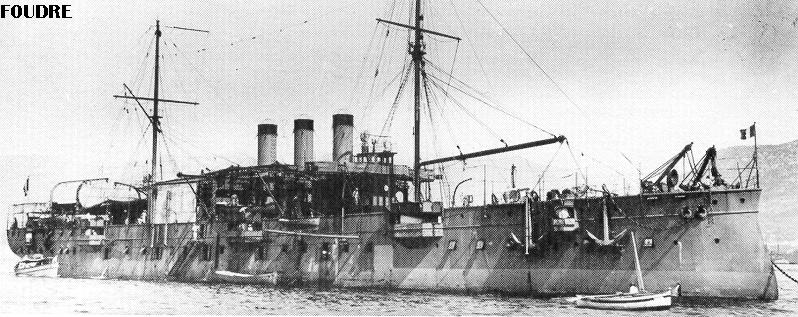
The Foudre was based during the war in Port Saïd, then Mudros (near the Gallipoli landings area) served in 1917 as a seaplane carrier, depot ship and tender for submarines, but also HQ and training ships before being decommissioned in 1921.
Links
The Foudre on wikipedia
Specs Conway’s all the world fighting ships 1860-1906.
La Foudre class specs (1914) |
|
| Dimensions | 118.8 x 15.5 x 7 m |
| Displacement | 6,100 tonnes FL |
| Crew | 430 |
| Propulsion | 2 screws, 2 Triple expansion engines, 24 boilers, 12,000 hp |
| Speed | 19 knots (35 km/h, xx mph) |
| Armament | 8 x 100 mm, 4 x 65 mm, 2 TTs, 4 floatplanes |
| Armor | Deck : 120 mm (4.7 in) |
Gallery

An illustration of La Foudre during the great war as seaplane carrier.
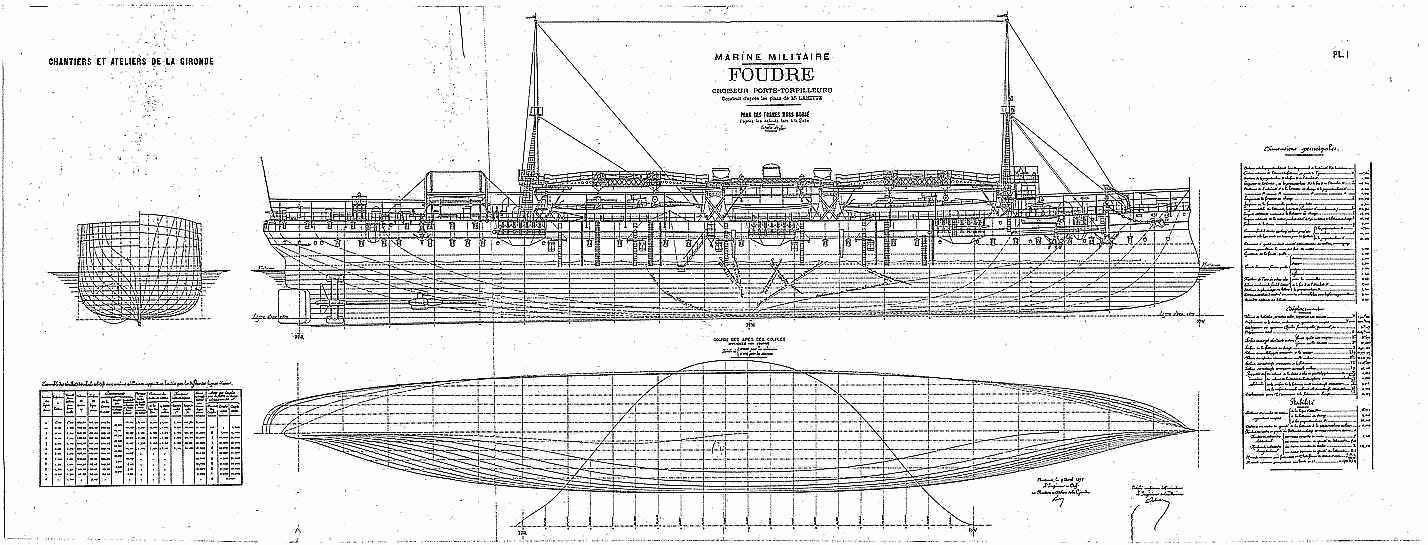
La Foudre, original plans 1890s
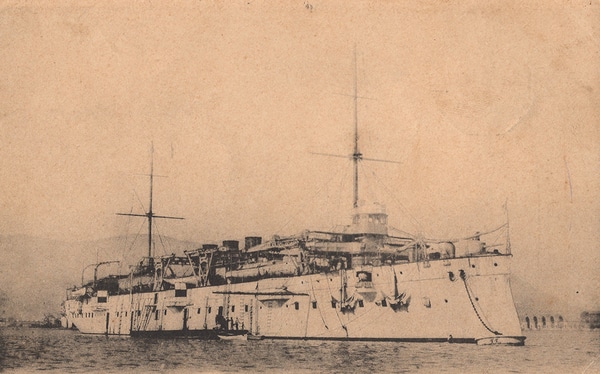
La Foudre in the 1890s
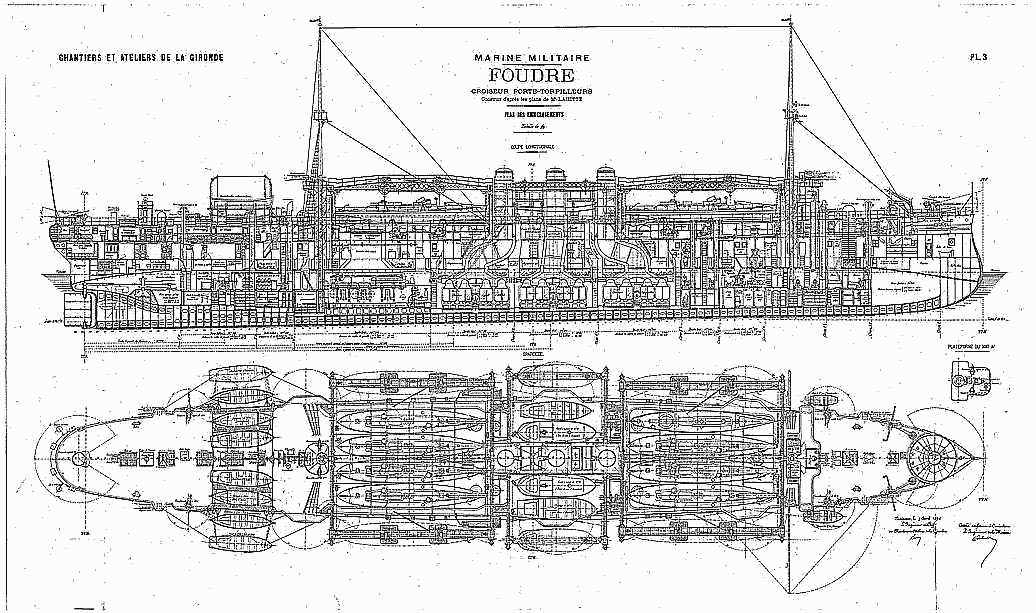
La Foudre, original plans 1890s
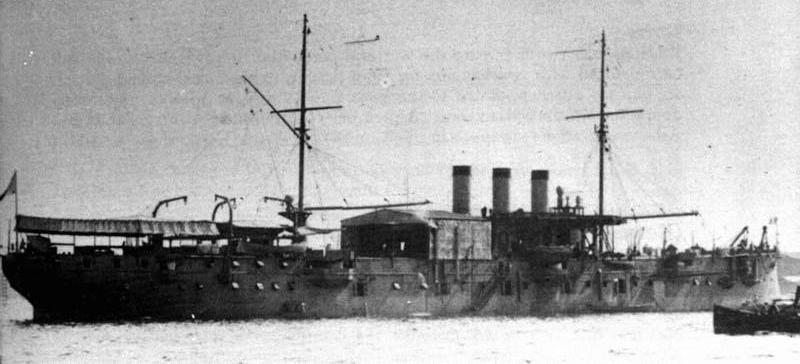

 Latest Facebook Entry -
Latest Facebook Entry -  X(Tweeter) Naval Encyclopedia's deck archive
X(Tweeter) Naval Encyclopedia's deck archive Instagram (@navalencyc)
Instagram (@navalencyc)





 French Navy
French Navy Royal Navy
Royal Navy Russian Navy
Russian Navy Armada Espanola
Armada Espanola Austrian Navy
Austrian Navy K.u.K. Kriegsmarine
K.u.K. Kriegsmarine Dansk Marine
Dansk Marine Nautiko Hellenon
Nautiko Hellenon Koninklije Marine 1870
Koninklije Marine 1870 Marinha do Brasil
Marinha do Brasil Osmanlı Donanması
Osmanlı Donanması Marina Do Peru
Marina Do Peru Marinha do Portugal
Marinha do Portugal Regia Marina 1870
Regia Marina 1870 Nihhon Kaigun 1870
Nihhon Kaigun 1870 Preußische Marine 1870
Preußische Marine 1870 Russkiy Flot 1870
Russkiy Flot 1870 Svenska marinen
Svenska marinen Søværnet
Søværnet Union Navy
Union Navy Confederate Navy
Confederate Navy Armada de Argentina
Armada de Argentina Imperial Chinese Navy
Imperial Chinese Navy Marinha do Portugal
Marinha do Portugal Mexico
Mexico Kaiserliche Marine
Kaiserliche Marine 1898 US Navy
1898 US Navy Sovietskiy Flot
Sovietskiy Flot Royal Canadian Navy
Royal Canadian Navy Royal Australian Navy
Royal Australian Navy RNZN Fleet
RNZN Fleet Chinese Navy 1937
Chinese Navy 1937 Kriegsmarine
Kriegsmarine Chilean Navy
Chilean Navy Danish Navy
Danish Navy Finnish Navy
Finnish Navy Hellenic Navy
Hellenic Navy Polish Navy
Polish Navy Romanian Navy
Romanian Navy Turkish Navy
Turkish Navy Royal Yugoslav Navy
Royal Yugoslav Navy Royal Thai Navy
Royal Thai Navy Minor Navies
Minor Navies Albania
Albania Austria
Austria Belgium
Belgium Columbia
Columbia Costa Rica
Costa Rica Cuba
Cuba Czechoslovakia
Czechoslovakia Dominican Republic
Dominican Republic Haiti
Haiti Hungary
Hungary Honduras
Honduras Estonia
Estonia Iceland
Iceland Eire
Eire Equador
Equador Iran
Iran Iraq
Iraq Latvia
Latvia Liberia
Liberia Lithuania
Lithuania Mandchukuo
Mandchukuo Morocco
Morocco Nicaragua
Nicaragua Persia
Persia San Salvador
San Salvador Sarawak
Sarawak Uruguay
Uruguay Venezuela
Venezuela Zanzibar
Zanzibar Warsaw Pact Navies
Warsaw Pact Navies Bulgaria
Bulgaria Hungary
Hungary

 Bundesmarine
Bundesmarine Dutch Navy
Dutch Navy Hellenic Navy
Hellenic Navy Marina Militare
Marina Militare Yugoslav Navy
Yugoslav Navy Chinese Navy
Chinese Navy Indian Navy
Indian Navy Indonesian Navy
Indonesian Navy JMSDF
JMSDF North Korean Navy
North Korean Navy Pakistani Navy
Pakistani Navy Philippines Navy
Philippines Navy ROKN
ROKN Rep. of Singapore Navy
Rep. of Singapore Navy Taiwanese Navy
Taiwanese Navy IDF Navy
IDF Navy Saudi Navy
Saudi Navy Royal New Zealand Navy
Royal New Zealand Navy Egyptian Navy
Egyptian Navy South African Navy
South African Navy






























 Ukrainian Navy
Ukrainian Navy dbodesign
dbodesign